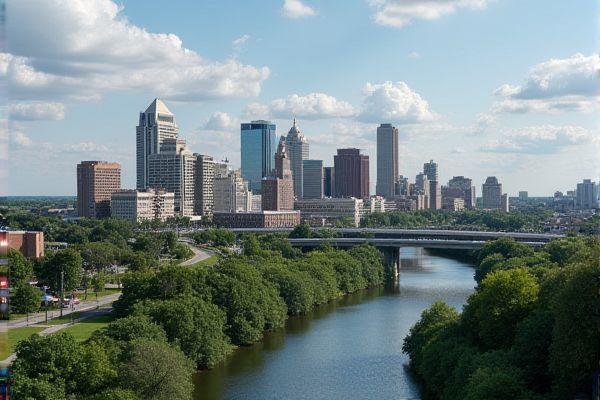
Insights from Indiana residents and expatriate communities: Cost of living. Local weather patterns. Public transportation options. Job market overview. Neighborhood safety levels. School and education quality. Local cultural attractions. Outdoor recreational activities. Healthcare facilities availability. Community events and festivals.
Cost of living.
The cost of living in Indiana is notably 8% lower than the national average, which can offer significant savings for residents. Housing costs in the state stand out as a major factor, being 22% lower than the average, making Indiana an attractive option for those looking to relocate. However, it's important to note that utilities are 4% higher, which might slightly offset the savings in other areas. Nonetheless, other essential categories, including food, healthcare, and transportation, are all below the national average, contributing to the overall affordability. For more detailed insights into living expenses in Indiana, you can explore the comprehensive analysis available at the RentCafe Cost of Living Calculator.
Local weather patterns.
Indiana residents enjoy a humid continental climate characterized by distinct seasons: hot and humid summers, cold winters, a wet and thunderstorm-prone spring, and a mild autumn. The state's weather varies significantly by region, with northern areas being colder and receiving more snow, while southern areas experience milder winters and increased rainfall.
Public transportation options.
Indiana residents, including expatriate communities, heavily rely on public transportation, with 88% of Marion County residents supporting its expansion. Public transit in Indianapolis is crucial for economic and social mobility, especially for those with lower incomes and disabilities, despite current challenges and legislative opposition. For more insights into the importance and ongoing developments of public transportation in Indiana, visit the IDS News website. This robust support highlights the community's recognition of the vital role public transit plays in enhancing residents' quality of life and fostering inclusive growth.
Job market overview.
Indiana's job market is strong, with private sector employment increasing by 10,500 jobs in January 2024 and a total gain of 42,000 jobs over the last year. The state has a low unemployment rate of 3.5% and a labor force participation rate of 63.0%, though the number of job openings has decreased to 141,000 as of September 2024, indicating a slightly slower growth in employer demand for workers. For detailed insights, the Indiana Department of Workforce Development provides comprehensive information about the current employment landscape in the state.
Neighborhood safety levels.
The city of Indianapolis experiences significantly higher crime rates compared to national averages, with a total crime rate of 43.82 per 1,000 residents. This includes a violent crime rate of 10.01 and a property crime rate of 33.81. In contrast, suburbs like Carmel, Zionsville, and Fishers exhibit much lower crime rates, highlighting a stark contrast in safety levels within the region. For a more detailed analysis, the Indianapolis Crime Rate offers further insights into these disparities and their implications for residents.
School and education quality.
Indiana is ranked as the 11th least educated state, placing 41st in educational attainment and 11th in quality of education. These rankings underscore significant gaps in the state's educational system when compared to other states. To learn more about this, visit the detailed study on Indiana's Educational System, which highlights these disparities and sheds light on potential areas for improvement.
Local cultural attractions.
Indiana is rich in local cultural attractions, including historic sites like the Auburn Cord Duesenberg Automobile Museum, the Eugene and Marilyn Glick Indiana History Center, and the Coffin House, which offer insights into the state's automotive, historical, and cultural heritage. These attractions provide a glimpse into Indiana's past, from its early statehood to its significant contributions to literature and the Underground Railroad. For more information on these historic and cultural places, you can explore the Arts and Culture Passport on Visit Indiana's website, which highlights these and other fascinating sites across the state.
Outdoor recreational activities.
Indiana residents and expatriate communities can indulge in a myriad of outdoor recreational activities, such as boating, ziplining, skiing, tubing, golfing, and exploring remarkable caves like Marengo Cave and Bluespring Caverns Park, in addition to visiting the numerous state parks and national forests scattered throughout the region. The area also offers diverse outdoor adventures including hiking, mountain biking, and horseback riding at O'Bannon Woods State Park, along with thrilling experiences like ziplining and free falling at Indiana Caverns. Visitors can enjoy recreational pursuits such as fishing and camping at Buffalo Trace Park. To delve deeper into these exciting opportunities, you can explore the wide range of offerings at Discover Southern Indiana, ensuring an unforgettable experience for nature lovers and adventure enthusiasts alike.
Healthcare facilities availability.
In Indiana, many residents face significant challenges in accessing healthcare due to a severe shortage of providers, with 67 counties designated as Medically Underserved Areas. Several counties lack hospitals and trauma services, requiring extensive travel for medical care. Meanwhile, for expatriate communities in Mexico, particularly American and Canadian expats, accessing quality healthcare is simplified by Lakeside Medical Group's comprehensive managed care model. This innovative approach addresses language barriers and the acceptance of existing insurance plans, providing a wide array of medical services to ensure seamless healthcare experiences.
Community events and festivals.
Indiana residents and expatriate communities can engage in a diverse array of community events and festivals, including the JA Wine and Beer Festival, Arab Fest, Germanfest, and numerous other cultural, music, and food festivals across cities like Indianapolis, Fort Wayne, and Bloomington. In Bloomington, the community offers a vibrant calendar of events, featuring international cuisine celebrations, live music, art gallery shows, and a variety of festivals that cater to diverse interests, making it an eclectic and engaging place for both locals and expatriates. Discover more about these exciting festivals at the Indiana Festivals Guide, which provides insights into the best events and cultural experiences throughout the state.
